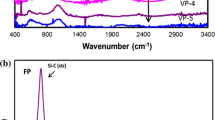Abstract
Thin silicon carbonitride SiCxNy films are synthesized by means of plasma enhanced chemical vapor deposition using an organosilicon compound such as bis(trimethylsilyl)ethylamine EtN(SiMe3)2 as the precursor in a mixture with hydrogen. The chemical composition and properties of the films are characterized by a set of modern research methods such as IR, Raman, and energy dispersive spectroscopy; ellipsometry; scanning electron microscopy; and spectrophotometry. The growth rate, chemical composition, and optical properties of the films have been studied depending on the synthesis temperature in the range from 373 to 1073 K. It is found that the substrate temperature exerts a significant effect on the growth kinetics, surface morphology, physicochemical properties, and functional characteristics of the films. Low temperature SiCxNy films have high transparency in the visible and infrared regions of the spectrum. Varying the parameter of synthesis allows one to obtain layers with different values of the refractive index (1.50–2.50).
Similar content being viewed by others
References
Hoffmann, P., Fainer, N., Kosinova, M., Baake, O., and Ensinger, W., Compilation on synthesis, characterization and properties of silicon and boron carbonitride films, in Silicon Carbide—Materials, Processing and Applications in Electronic Devices, Mukherjee, M., Ed., Rijeka, Croatia: InTech, 2011, ch. 21, pp. 487–546.
Ermakova, E., Mogilnikov, K., Rumyantsev, Yu., Kichay, V., Maximovskii, E., Semenova, O., and Kosinova, M., Study of Cu diffusion behavior in carbon rich SiCN: H films deposited from trimethylphenylsilane, Thin Solid Films, 2015, vol. 588, pp. 39–43.
Carvalho, A.T., Carvalho, R.A., Silva, M.L.P., and Demoarquette, N.R., Hydrophobic plasma polymerized hexamethyldisilazane thin films: Characterization and uses, Mater. Res., 2006, vol. 9, no. 1, pp. 9–13.
Chang, S.V., Tsai, H.C., Chang, J.V., Lin, S.J., and Chang, Y.S., Analysis of interface adhesion between porous SiOCH low-k film and SiCN layers by nanoindentation and nanoscratch tests, Thin Solid Films, 2008, vol. 516, pp. 5334–5338.
Kobayashi, K., Yokoyama, H., and Endoh, M., Leakage current and paramagnetic defects in SiCN dielectrics for copper diffusion barriers, Appl. Surf. Sci., 2008, vol. 254, pp. 6222–6225.
Fainer, N.I. and Nemkova, A.A., Optical properties of silicon carbonitride films produced by plasma-induced decomposition of organic silicon compounds, High Energy Chem., 2015, vol. 49, no. 4, pp. 273–281.
Kraus, F., Cruz, S., and Muller, J., Plasmopolymerized silicon organic thin film from HMDSN for capacitive humidity sensors, Sens. Actuators B: Chem., 2003, vol. 88, pp. 300–311.
Boughaba, S., Sproule, G.I., McCaffrey, J.P., Islam, M., and Graham, M.J., Synthesis of amorphous silicon carbonitride films by pulsed laser deposition, Thin Solid Films, 2002, vol. 402, pp. 99–110.
Chen, L.C., Chen, K.H., Wei, S.L., Kichambare, P.D., Wu, J.J., Lu, T.R., and Kuo, C.T., Crystalline SiCN: A hard material rivals to cubic BN, Thin Solid Films, 1999, vols. 355–356, pp. 112–116.
Wrobel, A.M., Blaszczyk-Lezak, I., Walkiewicz-Pietrzykowska, A., et al., Hard and high-temperatureresistant silicon carbonitride coatings based on N-silylsubstituted cyclodisilazane rings, J. Electrochem. Soc., 2008, vol. 155, no. 4, pp. K66–K76.
Ma, Z., Zhou, J., Chen, Z., and Xie, E., Luminescence properties of terbium-doped SiCN thin films by rf magnetron reactive sputtering, Diamond Relat. Mater., 2011, vol. 20, pp. 475–479.
Kleps, I. and Angelescu, A., Correlations between properties and applications of the CVD amorphous silicon carbide films, Appl. Surf. Sci., 2001, vol. 184, pp. 107–112.
Sysoev, S.V., Kolontaeva, A.O., Nikulina, L.D., Kosinova, M.L., Kuznetsov, F.A., Rakhlin, V.I., Lis, A.V., and Voronkov, M.G., films based on the phases in the Si–C–N system: Part 1. Synthesis and characterization of bis(trimethylsilyl)ethylamine as a precursor, Glass Phys. Chem., 2012, vol. 38, no. 1, pp. 8–14.
Fainer, N.I., Golubenko, A.N., Rumyantsev, Yu.M., and Maksimovskii, E.A., Use of hexamethylcyclotrisilazane for preparation of transparent films of complex compositions, Glass Phys. Chem., 2009, vol. 38, no. 3, pp. 274–283.
Ferrari, A.C. and Robertson, J., Interpretation of Raman spectra of disordered and amorphous carbon, Phys. Rev. B, 1999, vol. 61, no. 20, pp. 14095–14107.
Author information
Authors and Affiliations
Corresponding author
Additional information
Original Russian Text © Yu.M. Rumyantsev, I.V. Yushina, M.L. Kosinova, 2017, published in Fizika i Khimiya Stekla.
Rights and permissions
About this article
Cite this article
Rumyantsev, Y.M., Yushina, I.V. & Kosinova, M.L. Films based on phases in a Si–C–N system. Part II. plasma chemical synthesis of SiC x N y :Н films from the mixture of bis(trimethylsilyl)ethylamine and hydrogen. Glass Phys Chem 43, 48–52 (2017). https://doi.org/10.1134/S1087659617010126
Received:
Published:
Issue Date:
DOI: https://doi.org/10.1134/S1087659617010126



